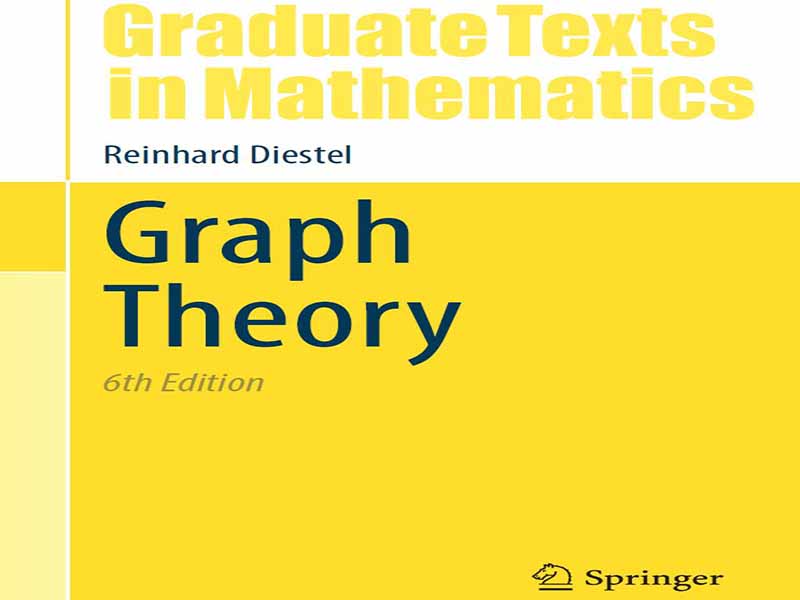- عنوان کتاب: Graph Theory, 6th Edition
- نویسنده: Leonid P. Lebedev
- حوزه: تئوری گراف
- سال انتشار: 2025
- تعداد صفحه: 466
- زبان اصلی: انگلیسی
- نوع فایل: pdf
- حجم فایل: 6.21 مگابایت
تقریباً دو دهه از ظهور آن متون تئوری گراف می گذرد که هنوز دستور کار اکثر دروس مقدماتی را که امروزه تدریس می شود تعیین می کنند. قانون ایجاد شده توسط آن کتاب ها به شناسایی برخی زمینه های اصلی مطالعه و تحقیق کمک کرده است و بدون شک برای مدتی آینده بر توسعه این رشته تأثیر خواهد گذاشت. با این حال، در این 20 سال چیزهای زیادی در نظریه گراف اتفاق افتاده است: قضایای عمیق جدیدی پیدا شده اند، روش ها و نتایج به ظاهر متفاوت به هم مرتبط شده اند، شاخه های کامل جدیدی پدید آمده اند. برای نام بردن تنها چند مورد از این پیشرفتها، میتوان به این فکر کرد که چگونه مفهوم جدید رنگآمیزی فهرست، شکاف بین متغیرهایی مانند درجه متوسط و عدد رنگی را پر کرده است، چگونه روشهای احتمالی و لم قاعدهمندی نظریه گراف افراطی و نظریه رمزی را فراگرفته است، یا اینکه چگونه حوزه کاملاً جدید مینورهای گراف و روشهای تجزیهطلبی استاندارد بلندمرتبهی درختی بر روی سطح شناسی، به ارمغان آورده است. مشکلات نمودار پس واضح است که زمان ارزیابی مجدد فرا رسیده است: امروزه حوزه ها، روش ها و نتایج اساسی که باید مرکز یک دوره مقدماتی تئوری گراف با هدف تجهیز مخاطبان خود برای محتمل ترین تحولات پیش رو باشد، کدامند؟ من در این کتاب سعی کرده ام مطالبی را برای چنین دوره ای ارائه کنم. با توجه به پیچیدگی و بلوغ فزاینده موضوع، من سنت تلاش برای پوشش نظریه و کاربردها را شکستم: این کتاب مقدمهای بر نظریه نمودارها به عنوان بخشی از ریاضیات (خالص) است. این شامل نه الگوریتم های صریح و نه برنامه های کاربردی «دنیای واقعی» است. امید من این است که پتانسیل عمیقی که با این محدودیت در دامنه به دست میآید، به دانشآموزان علوم رایانه به همان اندازه همسالان خود در ریاضیات خدمت کند: با فرض اینکه آنها الگوریتمها را ترجیح میدهند، اما از مواجهه با ریاضیات ناب از نوعی سود میبرند، به نظر میرسد فرصتی ایدهآل برای جستجوی این نزدیک به جایی که قلبشان نهفته است! در انتخاب و ارائه مطالب، سعی کرده ام دو هدف متضاد را در نظر بگیرم. از یک طرف، من معتقدم که یک متن مقدماتی باید ناب باشد و بر موارد ضروری تمرکز کند تا بتواند برای کسانی که تازه وارد این حوزه شده اند راهنمایی کند. بهعلاوه، بهعنوان یک متن فارغالتحصیل، باید به سرعت به اصل موضوع بپردازد: از این گذشته، ایده این است که حداقل برداشتی از عمق و روشهای موضوع را منتقل کند. از سوی دیگر، نگرانی خاص من این بوده است که با جزئیات کافی بنویسم تا متن لذتبخش و خوانا باشد: سؤالات و ایدههای راهنما به صراحت مورد بحث قرار خواهند گرفت و تمام شواهد ارائه شده دقیق و کامل خواهند بود. بنابراین، یک فصل معمولی با بحث مختصری در مورد سؤالات راهنما در حوزه ای که پوشش می دهد شروع می شود، با شرح مختصری از نتایج کلاسیک آن (اغلب با اثبات های ساده شده) ادامه می یابد و سپس یک یا دو قضیه عمیق تر ارائه می دهد که طعم کامل آن حوزه را نشان می دهد. اثبات این نتایج اخیر معمولاً با گزارشی غیررسمی از ایدههای اصلی آنها (یا در هم آمیخته میشود)، اما سپس به طور رسمی در همان سطح از جزئیات با همتایان سادهترشان ارائه میشوند. به زودی متوجه شدم که در نتیجه، برخی از آن اثباتها نسبت به تصور اغلب زیبا و سادهشان منصفانه به نظر میرسند، نسبتاً طولانیتر به چاپ رسیدند. با این حال، من امیدوارم که حتی برای خواننده حرفه ای شرح نسبتاً دقیق آن شواهد حداقل به حداقل رساندن زمان خواندن کمک کند. . . در صورت تمایل، این متن را می توان برای یک دوره سخنرانی با کمی یا بدون آمادگی بیشتر استفاده کرد. سادهترین راه برای انجام این کار، پیروی از ترتیب ارائه، فصل به فصل است: جدا از دو استثنای مشخص شده، هر نتیجهای که در اثبات دیگران استفاده میشود، مقدم بر آنها در متن است.
Almost two decades have passed since the appearance of those graph theory texts that still set the agenda for most introductory courses taught today. The canon created by those books has helped to identify some main fields of study and research, and will doubtless continue to influence the development of the discipline for some time to come. Yet much has happened in those 20 years, in graph theory no less than elsewhere: deep new theorems have been found, seemingly disparate methods and results have become interrelated, entire new branches have arisen. To name just a few such developments, one may think of how the new notion of list colouring has bridged the gulf between invariants such as average degree and chromatic number, how probabilistic methods and the regularity lemma have pervaded extremal graph theory and Ramsey theory, or how the entirely new field of graph minors and tree-decompositions has brought standard methods of surface topology to bear on long-standing algorithmic graph problems. Clearly, then, the time has come for a reappraisal: what are, today, the essential areas, methods and results that should form the centre of an introductory graph theory course aiming to equip its audience for the most likely developments ahead? I have tried in this book to o↵er material for such a course. In view of the increasing complexity and maturity of the subject, I have broken with the tradition of attempting to cover both theory and applications: this book o↵ers an introduction to the theory of graphs as part of (pure) mathematics; it contains neither explicit algorithms nor ‘real world’ applications. My hope is that the potential for depth gained by this restriction in scope will serve students of computer science as much as their peers in mathematics: assuming that they prefer algorithms but will benefit from an encounter with pure mathematics of some kind, it seems an ideal opportunity to look for this close to where their heart lies! In the selection and presentation of material, I have tried to accommodate two conflicting goals. On the one hand, I believe that an introductory text should be lean and concentrate on the essential, so as to o↵er guidance to those new to the field. As a graduate text, moreover, it should get to the heart of the matter quickly: after all, the idea is to convey at least an impression of the depth and methods of the subject. On the other hand, it has been my particular concern to write with sufficient detail to make the text enjoyable and easy to read: guiding questions and ideas will be discussed explicitly, and all proofs presented will be rigorous and complete. A typical chapter, therefore, begins with a brief discussion of what are the guiding questions in the area it covers, continues with a succinct account of its classic results (often with simplified proofs), and then presents one or two deeper theorems that bring out the full flavour of that area. The proofs of these latter results are typically preceded by (or interspersed with) an informal account of their main ideas, but are then presented formally at the same level of detail as their simpler counterparts. I soon noticed that, as a consequence, some of those proofs came out rather longer in print than seemed fair to their often beautifully simple conception. I would hope, however, that even for the professional reader the relatively detailed account of those proofs will at least help to minimize reading time. . . If desired, this text can be used for a lecture course with little or no further preparation. The simplest way to do this would be to follow the order of presentation, chapter by chapter: apart from two clearly marked exceptions, any results used in the proof of others precede them in the text.
این کتاب را میتوانید از لینک زیر بصورت رایگان دانلود کنید:
Download: Graph Theory, 6th Edition




































نظرات کاربران